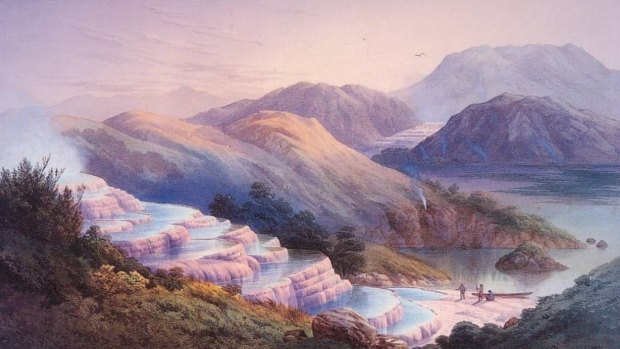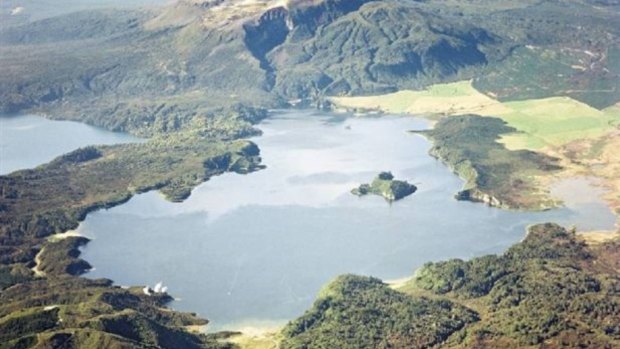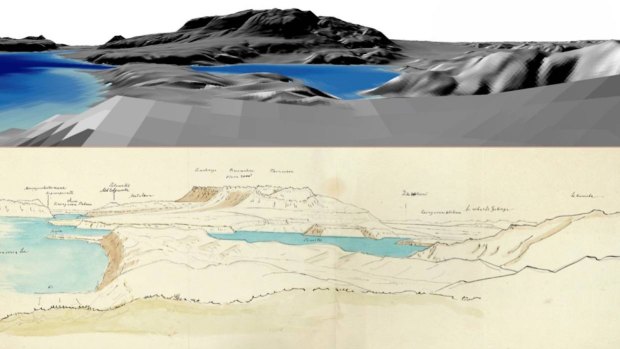This was published 5 years ago
Pink and White Terraces, New Zealand: Scientists confirm location of lost natural wonder
By Brad Flahive

JC Hoyte's painting of the Pink and White Terraces in the 1870s, prior to the eruption of Mt Tarawera in 1886.Credit: HOCKEN COLLECTIONS
A 19th century diary and hand-drawn maps have led scientists at New Zealand's National Institute of Water and Atmospheric Research to confirm the location of the country's lost natural wonder - the Pink and White Terraces.
Niwa looked over the only known formal survey of Lake Rotomahana - 20 kilometres south-east of Rotorua - before the 1886 eruption of Mt Tarawera.
German-Austrian geologist Ferdinand von Hochstetter's survey included important details about the terraces, small geothermal features around the lake and some distant landmarks.

Pink and White Terraces, New Zealand: Scientists confirm location of lost natural wonder The Pink and White Terraces were buried underneath Lake Rotomahana, south of Rotorua, by the Mt Tarawera eruption in 1886.Credit: GNS SCIENCE
"Our research agrees with previous findings by Professor Ron Keam and GNS Science that the former sites of the terraces are under the modern Lake Rotomahana," Dr Andrew Lorrey said.
The fabled Pink and White Terraces, also known as Te Otukapuarangi, were once dubbed the eighth wonder of the world and were a thriving tourist destination, attracting people from overseas.
The terraces formed over thousands of years as silica-rich water emerging from springs and boiling geysers crystallised into giant tiered staircases. The White Terrace covered more than three hectares while the smaller Pink Terrace was used for bathing on the lower levels. There was also a smaller, lesser known feature called Tuhi's Spring, or the Black Terrace.

Top: Digital elevation oblique view of Mount Tarawera and the surrounding landscape near Lake Tarawera based on von Hochstetter's (1859) survey notes. Bottom: Watercolor and pencil sketch of the same view crafted by Ferdinand von Hochstetter April 1859.Credit: Nolden Nolden 2013
They disappeared after the Mt Tarawera eruption which was the largest and most destructive in New Zealand since the early 19th century. It devastated the surrounding countryside, destroyed several villages and was responsible for about 120 deaths.
Lorrey and fellow Niwa scientist John-Mark Woolley evaluated von Hochstetter's diary notes and reconstructed his survey sites and stations around Lake Rotomahana using a remote sensing system that uses light pulses to measure distance and topography.
They combined that information with sketches drawn by von Hochstetter and a map published in 1862 to pinpoint the former location of the terraces.
Von Hochstetter's notes contained several other draft maps which were progressively refined as he worked.
"You can see how he reconsidered two or three times how to draw things and how to orientate them," Lorrey said.
"The published map is faithful to the diary measurements, and the results we obtained align to previous research on where the terraces might be."
The outcome demonstrated the accuracy and utility of historic documents for scientific research, he said.
The latest research by Niwa was carried out at the request of Tūhourangi Tribal Authority following conflicting findings about the former location of site.
The eruption of Tarawera was so violent it was heard in Auckland and in the South Island. It left a 17km-long gash through Mt Tarawera and south-westward beneath the lake. After the eruption, the lake level rose at least 60 metres and its area grew about five times.
GNS scientist Cornel De Ronde talked about the eruption and its impact in a 2011 YouTube video.
In August, GNS Science researchers claimed the white terraces were largely destroyed, while remnants of the pink terraces may lie at the bottom of the lake.
The new Niwa results have been published today in scientific journal Frontiers of Earth Science.
What were the terraces like?
Holiday destinations were a little different in the 1860s. For the aristocrats who had the time and money to to travel, visiting the world's natural wonders was incredibly popular. Instagram hadn't ruined the best spots.
As was visiting spa towns that promised healing qualities from its water warmed by thermal activity - places like Bath, England and Montecatini Terme in Italy flourished from the pilgrimage of wealthy folk hoping to stave off Father Time.
So for the privileged few that could reach little ol' Aotearoa in the late 1800s, the promise of both a natural wonder and a living-giving experience would have made the more than 75-day voyage from Europe just bearable.
The terraces formed over thousands of years as silica-rich water emerging from springs and boiling geysers crystallised into giant tiered staircases. The White Terrace covered more than three hectares while the smaller Pink Terrace was used for bathing on the lower levels. There was also a smaller, lesser known feature called Tuhi's Spring, or the Black Terrace.
They disappeared after the 1886 eruption of Mt Tarawera which was the largest and most destructive in New Zealand since the early 19th century. It devastated the surrounding countryside, destroyed several villages and was responsible for about 120 deaths.
The news of the discovery of their location led to questions about whether the terraces could resurface and allow us to bathe like it was 1869. But Niwa's Dr Andrew Lorrey said the latest research did not cover whether they were still intact.
"There is a lot more science that is yet to be done to see what's down there," he told Stuff.
In 2011, scientists explored the bottom of the lake using robotic underwater vehicles, and the data collected clearly showed crescent-shaped terraced structures in about 60 metres of water where the Pink Terraces were located prior to 1886.
Cornel de Ronde, of GNS Science said at the time they were "95 per cent certain" the sonar images were the "bottom two tiers of the Pink Terraces".
"One shot looks like a butterss of a silica terrace … it's encouraging that there is much more to be seen," Lorrey said.
Any decision to drain the lake to make the terraces an attraction again would be made by Tūhourangi, but Lorrey said augmented reality technology could make such extensive work unnecessary.
A specially-developed AR app, launched by Waimangu Volcanic Valley and built by Rotorua company Digital Elements, alongside Specialist Apps in Australia, is set to bring the terraces back to life.
Waimangu Volcanic Valley chairman, Alan Skipwith (Tūhourangi) told Māori Television the app is the closest thing to restoring the natural taonga of Te Tarata and Otukapurangi and will be amazing to see visitors experience the re-created terraces.
"For many New Zealanders, the Pink and White Terraces formed part of the classroom curriculum.
"For international visitors, they're intrigued because so many European travellers gathered on its shores to experience the natural spa and health benefits the terraces provided, as well as the mystery about where they are now."
Although the Pink and White Terraces will be a key attraction, the app also reveals other geological insights.
The app has been in development since February 2018 and is free to download on Apple and Android devices.
Sign up for the Traveller Deals newsletter
Get exclusive travel deals delivered straight to your inbox. Sign up now.